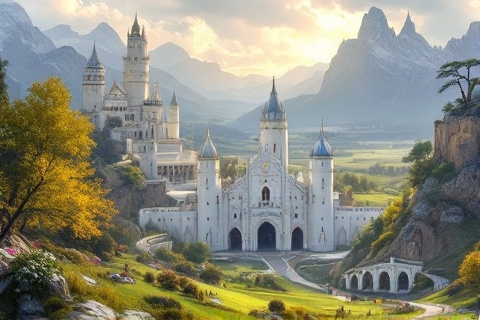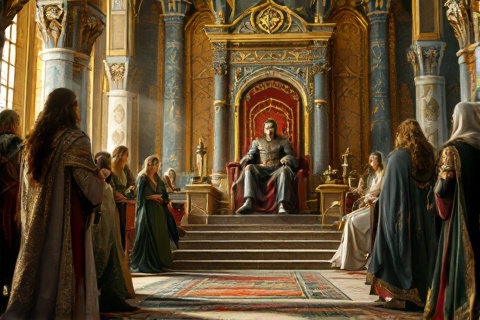
The Tale of Tuor and the Coming to Gondolin: Destiny in Tolkien's Legendarium
The Journey of Tuor and the Fate of a Hidden City
Origins of the Tale: From Tolkien's Early Writings to Unfinished Tales
The Tale of Tuor and the Coming to Gondolin first emerged in
J.R.R. Tolkien's earliest writings of 'The Book of Lost Tales,' composed during
his recovery from trench fever after World War I. The story evolved
significantly over the decades, eventually finding a more complete form in
'Unfinished Tales of Númenor and Middle-earth,' though it
remained unfinished at the time of Tolkien's death.
Christopher Tolkien's meticulous editorial work brought this remarkable tale to
readers through multiple publications. His efforts included organizing and
annotating his father's manuscripts, providing crucial context and commentary in
both 'Unfinished Tales' and 'The History of Middle-earth' series, particularly
in 'The Book of Lost Tales Part Two.' His detailed analysis helped readers
understand the tale's evolution and its place in the broader mythology.
This story holds exceptional importance within the First Age
narratives as it connects several crucial elements of Tolkien's legendarium. It
bridges the gap between the fall of the Noldorin realms and the eventual
salvation of Middle-earth through Eärendil,
establishing vital links between the fates of Elves and
Men. The tale represents a unique intersection of divine
intervention, mortal destiny, and the complex relationships between the Free
Peoples of Middle-earth.
Tuor's Early Life and Divine Call

Tuor's life began in 472 of the First Age, amid the tragic aftermath of the
Nírnaeth Arnoediad or Battle of Unnumbered Tears. His father Huor fell in that
devastating conflict while protecting the retreat of Turgon's forces, and his
mother Rían, overcome by grief, perished upon the Haud-en-Ndengin where the dead
were piled. This noble lineage and tragic beginning would shape Tuor's destiny
in profound ways.
The young Tuor found sanctuary with the Grey-elves of Mithrim,
who raised him in the hidden caves of Androth. Under their care, he learned the
lore and language of the Elves, developing skills in both woodcraft and warfare.
These years of secret dwelling helped forge his character and prepared him for
the great journey that lay ahead.
Throughout his youth, Tuor felt an inexplicable attraction to the waters of
Mithrim, often lingering by streams and waterfalls. The Vala
Ulmo, Lord of Waters, began sending him messages through the music of streams
and the voices of storms, slowly awakening in him a desire to seek out his
destiny. These signs grew stronger as Tuor reached manhood, becoming
unmistakable signals of divine guidance.
The crucial turning point came when Tuor encountered Gelmir, an Elf of
Nargothrond, who recognized in him the chosen messenger of
Ulmo. Gelmir led Tuor westward to the Gates of Nevrast, marking the beginning of
his prophesied journey. This meeting was no chance occurrence but part of Ulmo's
carefully orchestrated plan to guide Tuor toward his ultimate destination.
The Abandoned Realm of Nevrast

Upon reaching Vinyamar, Tuor discovered the ancient halls of
King Turgon, abandoned three hundred years earlier when the
Noldor departed for Gondolin. The great halls beneath Mount
Taras stood as a testament to Noldorin craftsmanship, their walls still bearing
the devices of Turgon's house. Though long deserted, these halls remained
preserved by Ulmo's power, waiting for Tuor's arrival.
In these halls, Tuor discovered the prophetic gift left by Turgon at Ulmo's
bidding: a shield, hauberk, helm, and sword. The shield bore the device of a
white swan-wing, while the helm was adorned with the likeness of Ulmo himself.
These arms and armor, created by the finest Noldorin craftsmen, would mark Tuor
as Ulmo's chosen messenger.
The most significant encounter at Vinyamar was with Voronwë, one of the mariners
sent by Turgon to seek the aid of the Valar in Valinor. As the
sole survivor of these missions, Voronwë had been saved from drowning by Ulmo
specifically to guide Tuor to Gondolin. Their meeting fulfilled ancient
prophecies and forged a friendship that would prove crucial for the journey
ahead.
Ulmo's Direct Intervention

At the shores of Nevrast, Tuor witnessed one of the most awe-inspiring events in
the history of Middle-earth: the rising of Ulmo himself from the Great Sea. The
Vala appeared in terrible majesty, towering like a mountain above the waters,
his deep voice rolling like thunder across the waves. This rare direct
intervention by one of the Valar emphasized the paramount importance of Tuor's
mission.
Ulmo revealed to Tuor the impending doom of Gondolin, yet also spoke of hope
that would arise from its fall. The Lord of Waters explained how the fate of
Elves and Men were intertwined, and that through Tuor's line would come the
salvation of both kindreds. This prophecy would later be fulfilled through
Eärendil, though in ways none could yet foresee.
The Vala provided specific instructions for finding Gondolin, telling Tuor to
follow the river Sirion southward and seek the hidden valley of Tumladen. Ulmo
warned that the journey would be perilous but promised that his protection would
extend as far as possible. These directions, though seemingly simple, would lead
Tuor through some of the most dangerous territories in Middle-earth.
The Perilous Journey to Gondolin
The journey through Dor-lómin proved treacherous as Tuor and
Voronwë navigated lands now controlled by Easterlings who served
Morgoth. They traveled in secret, avoiding the occupied
settlements where Tuor's own people had once dwelled, using their knowledge of
the wilderness to remain undetected. The harsh winter conditions added to their
trials, testing their endurance and resolve.
Voronwë's expertise proved invaluable as he led Tuor through hidden paths and
secret ways known only to the Elves. They followed the course of the river
Sirion, using its waters as both guide and protection, for Ulmo's power still
flowed strong in that stream. Their journey took them through the Fell Winter,
where every step could have meant discovery or death.
Despite their caution, they faced several encounters with Morgoth's servants.
Orcs patrolled the lands, and fell creatures lurked in the
shadows. Each confrontation required cunning and courage to survive, with Ulmo's
protection manifesting in subtle ways to aid their escape. These challenges
served to strengthen Tuor's resolve and prepare him for his crucial role.
The final leg of their journey brought them to the Encircling Mountains, where
they had to find the secret way into the hidden valley of Tumladen. This
passage, known only to the Eagles of Thorondor and trusted allies of Gondolin,
required precise timing and knowledge to navigate successfully. The discovery of
this path marked the near completion of their long and perilous journey.
The Hidden City Revealed

After emerging from the hidden passage, Tuor and Voronwë beheld the magnificent
sight of Gondolin spread across the plain of Tumladen. The white city gleamed in
the morning sun, its towers reaching toward the sky like silver needles. This
first glimpse of the hidden realm, nestled within its protective ring of
mountains, revealed why it was considered the most beautiful city ever built by
the Noldor in Middle-earth.
The seven gates of Gondolin represented both the city's impregnable defenses and
its architectural splendor. From the Gate of Wood to the final Gate of Steel,
each entrance was a masterwork of Noldorin craftsmanship, incorporating unique
materials and magical properties. The sequence of gates served as a testament to
the skill and foresight of Turgon's people in creating their hidden sanctuary.
Gondolin's architecture reflected the height of Noldorin achievement in
Middle-earth. The city was built to mirror Tirion upon Túna in
Valinor, with white walls and high towers that captured and reflected the light.
Its squares were paved with marble, its fountains sang day and night, and its
buildings housed countless treasures of art and learning. The city stood as a
preserved fragment of the Blessed Realm east of the sea.
Meeting with King Turgon

Upon reaching the king's hall, Tuor delivered Ulmo's warning with all the
authority granted to him as the Vala's messenger. Speaking with divine
inspiration, he urged Turgon to abandon the city and seek refuge at the Havens
of Sirion, warning that Gondolin's secrecy would soon fail. The gravity of this
message resonated through the great hall, as all present recognized the weight
of Ulmo's words.
Despite the clear divine origin of the warning, Turgon chose to remain in
Gondolin. His pride in the city's strength and his trust in its secrecy led him
to reject Ulmo's counsel, though he received Tuor with honor. This fateful
decision would eventually lead to the city's downfall, as Ulmo had foretold.
The king's acceptance of Tuor into his court marked a significant moment in the
history of Elves and Men. Turgon granted Tuor noble status and welcomed him as a
member of his household, recognizing in him the nobility of his forebears. This
acceptance would have far-reaching consequences for the futures of both
kindreds.
The House of the Wing
Tuor's elevation to lordship over the House of the Wing represented a remarkable
honor for a mortal in an Elven realm. The king granted him authority to
establish his own noble house, marked by the emblem of the white wing that had
adorned the shield he found in Vinyamar. This new house quickly became one of
the most respected in Gondolin, attracting both Elves and Men to its service.
The white wing emblem carried deep symbolic meaning, connecting Tuor's destiny
to both Ulmo's guidance and the ultimate fate of Gondolin. It represented hope,
freedom, and the protection of the Valar, while also foreshadowing the important
role his descendants would play in the skies above Middle-earth. The symbol
became synonymous with Tuor's unique position as a bridge between the kindreds.
As lord of his house, Tuor's influence in Gondolin grew significantly. His
wisdom and valor earned him the respect of the Gondolindrim, while his unique
status as Ulmo's messenger gave his words special weight in the king's councils.
Though some initially viewed him with skepticism, his leadership abilities and
noble character soon proved his worthiness of the honor bestowed upon him.
Love and Legacy: Tuor and Idril

The love story between Tuor and Idril Celebrindal stands as one of the most
significant romances in the First Age. Unlike the tragic tale of Beren and
Lúthien, theirs was a union blessed from its
beginning, free from the obstacles that usually hindered marriages between Elves
and Men. Their mutual attraction grew naturally from admiration and respect,
blossoming into a deep and lasting love.
Their marriage in 502 of the First Age symbolized the possibility of hope even
in dark times. The celebration lasted for days, bringing joy to all of Gondolin.
Their union represented more than personal happiness; it symbolized the
potential for harmony between the kindreds of Elves and Men, offering a glimpse
of how these races could complement and strengthen each other.
The birth of their son Eärendil in 503 marked a crucial moment in the history of
Middle-earth. The child inherited the best qualities of both lineages: the
nobility and strength of Men combined with the grace and wisdom of the Eldar.
His very existence would prove crucial to the salvation of Middle-earth, though
none could have foreseen the full scope of his destiny at the time of his birth.
The significance of Tuor and Idril's union extended far beyond their own time.
Through their son Eärendil and his sons after him, their bloodline would
influence the history of Middle-earth for ages to come. The joining of their
houses would eventually lead to the establishment of the lines of both Elven and
Númenórean kings, shaping the destiny of countless
generations.
Themes of Fate and Free Will
Divine intervention, particularly through Ulmo's consistent guidance, played a
crucial role throughout Tuor's journey. Unlike most interactions between the
Valar and the inhabitants of Middle-earth during the First Age, Ulmo's
involvement in Tuor's life was direct and personal. This exceptional level of
divine guidance underscored the crucial importance of Tuor's mission to the
overall fate of Middle-earth.
The contrasting responses to divine guidance between Tuor and Turgon highlight a
central theme in Tolkien's works about free will and destiny. While Tuor
embraced his role as Ulmo's messenger and remained open to divine guidance,
Turgon's rejection of the Vala's warning stemmed from pride and over-confidence
in his own wisdom. These choices had profound consequences for both individuals
and the fate of Gondolin.
The tale of Tuor exemplifies several key themes within Tolkien's broader
legendarium: the interaction between divine will and mortal choice, the
potential for cooperation between different races, and the long-term
consequences of individual decisions. His story demonstrates how seemingly small
choices can have far-reaching effects, ultimately contributing to the greater
patterns of history in Middle-earth.
